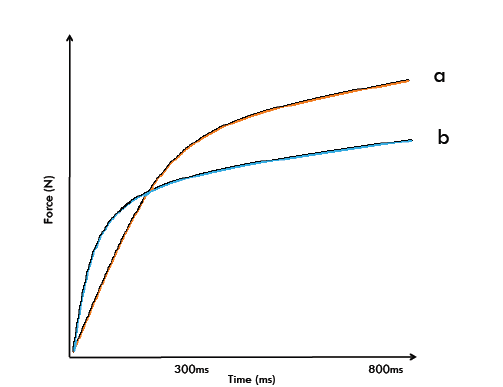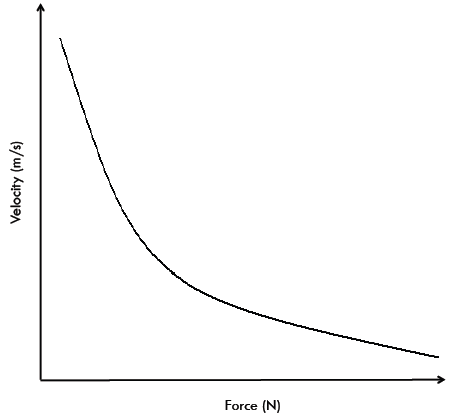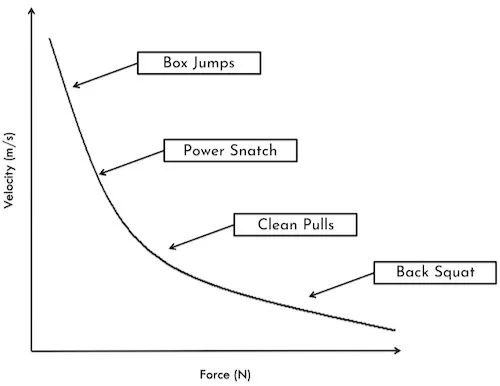Power is defined as Force*Velocity, and in sports that means using strength at speed. Think of a big tackle in rugby, an explosive dunk in basketball, or even a swimmer’s stroke: they all require good levels of strength, but there is a massive speed element to these actions as well. It’s important to be extremely strong (read why here), but if it takes a long time for you to develop that force then you’ll likely miss the opportunity to use it. Maximum strength takes ~0.6 seconds to develop, whereas the majority of athletic movements happen in less than 0.3 seconds; for example, ground contact time in sprinting is about 0.1 seconds. As such, the speed at which someone can produce the force, or Rate of Force Development (RFD) is vitally important. Ultimately, we want all of our athletes to be as strong as possible and have a high RFD so that they can perform at their best no matter the context.
In the example above, athlete b would likely be a better sprinter as they can develop force more quickly. However, athlete a would be better in a rugby scrum, as they will have the time to develop their higher maximum force
When it comes to improving RFD, we can’t simply use the same exercises that we use to develop strength. Excellent strength exercises like the Squat, Bench Press, Deadlift have a deceleration component to them that stops them from being effective at developing power. Explosive movements that don’t require deceleration in the propulsive phase (think jumps and throws) are highly effective at developing power, and research by Newton et al showed that a ballistic exercise training programme led to increases in athletes’ strength, speed and power (1). Strength is also an incredibly important aspect of power, as the more force an athlete can produce, the more they can harness and express as power. A range of studies have shown strong relationships between 1RM Bench Press & 1RM Squat and maximum power.
The next consideration for power training is what load should the exercises be for maximum power production? Force and velocity (speed) have an inverse relationship: the more force required to do a task, the longer it takes to execute. You’re able to push a pram much more quickly than you can push a car, and that’s a perfect demonstration of the Force-Velocity relationship.
When Velocity is at its highest, Force is at its lowest, and vice versa.
So, if Power is Force*Velocity, where is the point of maximum power? That depends on the exercise: in a Power Clean, maximum power will be at around 80% 1RM, whereas in a vertical jump, maximum power occurs with no additional load (2). Power development is also specific: in a landmark 1978 study by Zatsiorsky and Karasiov (3), they took Shot Putt athletes and split them into three groups: light shot, medium shot, and heavy shot. Those who trained with the light shot got better at throwing the light shot, but not the medium or heavy one; those who trained with the medium shot got better at throwing the medium shot, but not the light or heavy one; those who trained with the heavy shot got better at throwing the heavy shot, but not the light or medium one. As such, it’s important to train all aspects of an athlete’s power, from unweighted Vertical Jumps to heavy Clean Pulls, as per the image below.
Training different aspects of an athlete’s Force-Velocity profile will require various exercises at various loads.
The Olympic Lifts (Snatch and Clean & Jerk) and their derivatives have often been used for power development, and in 2011 Comfort et al. (4) examined various Power Clean variations’ maximum Force and RFD. They found that simpler exercises like a Jump Shrug were better than the more complex Power Clean for maximum Force and RFD. This finding was backed up by Suchomel et al. in 2014 (5), illustrating how limiting the skill aspect of an exercise can be for power production.
As well as producing force during a single rep or attempt, athletes need to be able to sustain power through an entire game, race, or bout. Power Endurance is a vital component of an athlete’s physical profile, and any effective Strength and Conditioning programme to maximise power must also train power endurance. There is good evidence showing that in a given set, power decreases significantly from rep 6 onwards (6), and using cluster sets has been shown to maintain power production across reps (7). In a cluster set, a couple of seconds’ rest is afforded to the athlete between reps, allowing for a small bit of recovery, clearing of any metabolic byproducts, and letting the athlete mentally refocus.
There are seven main qualities that contribute to an athlete’s ability to produce power (8):
Maximum Strength (e.g 1RM Back Squat)
Strength-Speed (e.g 3RM Power Cleans)
Speed-Strength (e.g Barbell Squat Jump)
Rate of Force Development or RFD (e.g Vertical Jump)
Reactive Strength (e.g Drop Jump)
Skill Performance (how proficient they are at the given task)
Power Endurance (how well they can maintain Power through several efforts)
Power training should prioritise the least developed quality, assessed via a thorough testing battery, and testing should be performed at regular intervals to reassess what training an athlete or group of athletes needs to maximise their power. At Innervate Performance we can perform all the necessary testing, training and workshops to have your athletes maximising their power when it matters most, and allow you to focus on what you do best. Get in touch to find out more at info@innervateperformance.com
References
Newton, R. U., Kraemer, W. J., Häkkinen, K., Humphries, B. J., & Murphy, A. J. (1996). Kinematics, Kinetics, and Muscle Activation during Explosive Upper Body Movements, Journal of Applied Biomechanics, 12(1), 31-43.https://doi.org/10.1123/jab.12.1.31
Cormie P, McCaulley GO, Triplett NT, McBride JM. Optimal loading for maximal power output during lower-body resistance exercises. Med Sci Sports Exerc. 2007 Feb;39(2):340-9. 10.1249/01.mss.0000246993.71599.bf
Zatsiorsky, V.M. & N.A.Karasiov. The Use of Shots of Various Weight in the Training of Elite Shot Putters. Sport Science Herald (Sponivno-Nauchny Vestnik), #4, pp.23-31,1978
Comfort P, Allen M, Graham-Smith P. Comparisons of peak ground reaction force and rate of force development during variations of the power clean. J Strength Cond Res. 2011 May;25(5):1235-9. https://doi.org/10.1519/jsc.0b013e3181d6dc0d
Suchomel TJ, Wright GA, Kernozek TW, Kline DE. Kinetic comparison of the power development between power clean variations. J Strength Cond Res. 2014 Feb;28(2):350-60. https://doi.org/10.1519/jsc.0b013e31829a36a3
Baker DG, Newton RU. Change in power output across a high-repetition set of bench throws and jump squats in highly trained athletes. J Strength Cond Res. 2007 Nov;21(4):1007-11. https://doi.org/10.1519/r-22376.1
Haff, G Gregory PhD, CSCSD, FNSCA1; Hobbs, Ryan T1; Haff, Erin E MA2; Sands, William A PhD3; Pierce, Kyle C EdD4; Stone, Michael H PhD, FNSCA5 Cluster Training: A Novel Method for Introducing Training Program Variation, Strength and Conditioning Journal: February 2008 - Volume 30 - Issue 1 - p 67-76. https://doi.org/10.1519/SSC.0b013e31816383e1
Newton, Robert U. PhD, CSCS; Dugan, Eric MSc, CSCS Application of Strength Diagnosis, Strength and Conditioning Journal: October 2002 - Volume 24 - Issue 5 - p 50-59
Will has a Master’s degree in Strength & Conditioning from Middlesex University, and is a published scientific author. Will has worked with athletes across a variety of sports including rugby, football, hockey, cycling, rowing, and recently was the Head of Strength & Conditioning for the inaugural year of the NFL Academy in North London. For more information about Innervate Performance, check out our coaches





